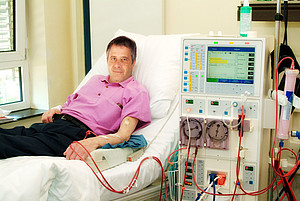Dialysis - An "artificial kidney"
According to the German Kidney Center, about 50,000 people have such a severe kidney illness, that they depend on lifelong blood purification: the dialysis. According to the dialysis experts Fresenius Medical Care, approximately 2.5 million people worldwide need dialysis to survive. Untreated, this could cause chronic or acute renal failure and death within a few weeks. The development of dialysis, also called "artificial kidney", was not possible without animal experiments and the use of non-human primates. Two different dialysis systems are currently used: hemodialysis outside the body in one machine (90 percent of all cases), dialysis with the aid of the peritoneum (peritoneal dialysis).
Hemodialysis
In hemodialysis, dialysis machines to which patients are regularly connected with certain special clinics are used as a replacement for the lost kidney function. During the initial implementation of a dialysis machine in 1913 by John Abel and his staff, anesthetized rabbits and dogs were necessary to prove that the process worked as intended. Dialysis is based on the following principle: Healthy kidneys filter toxic substances from the blood and then these toxins are disposed of through the urine. In cases of kidney failure, this vital function must be replaced by another filter: either a semi-permeable membrane in an external device or the peritoneum (see below). For this purpose, the blood of the patient must be passed through this membrane for a certain period of time.
Animal experiments also helped to overcome the first difficulty with coagulation inhibitors for the filtered blood. Heparin, which is still used today was initially isolated from dog liver and in the 1930s in larger quantities from bovine liver. In the meantime, improved dialysis membranes were developed from cellophane as well as dialysis machines, where less blood is needed. These developments paved the way for the Dutchman Willem Kolff who carried out the first successful treatment of a patient with acute renal failure in 1945.
Thanks to techniques that were developed in the 1960s to access veins ("Scribner shunts"), the establishment of the first chronic dialysis program was successfully implemented in Seattle. As with the development of the polio vaccine, Belding Scribner and the developers of this technique renounced a patent to ensure that the life-sustaining method could spread faster. Following initial success, medical practitioners established hemodialysis through the improvement of membrane materials and dialysis devices worldwide.
You can learn more about hemodialysis in this video provided by the Techniker Krankenkasse.
Peritoneal dialysis
A major disadvantage of hemodialysis machines is that the patient must be connected to it several times a week for a few hours. An alternative is to the hemodialysis is the peritoneal dialysis. It was also developed through experiments on guinea pigs, rabbits, dogs and monkeys in the 1920s in Germany and the USA. This ultimately led to the development of various modern systems of this type of dialysis.
The peritoneum is a thin skin which completely lines the abdominal cavity. It is very well circulated and is therefore an ideal natural exchange membrane. Through the hydraulic process of osmosis on which every dialysis is based, the toxic metabolic products are transferred from the peritoneum to the dialysis fluid. After a while, the fluid from the peritoneum is drained again and replaced. This refined technique also works for the patient at home and even at night during their sleep.
However, many people with chronic renal failure are weakened by other diseases and therefore this method is not an option for every patient.
This video shows two types of dialysis procedures for removing waste and excess fluid in the body when the kidneys stop functioning properly.

